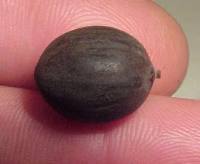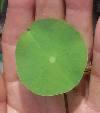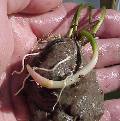
|
Growing
Nelumbo (Lotus)
From Seed
& Seedling Cultivation
By Walter Pagels
Photos by Kit Knotts - Click to enlarge |
|
The Lotus Seed Survival Tactic
The seed of the Lotus (Nelumbo sp.) is a very hard
nut and is almost completely impermeable to water. It remains
viable for many years; some evidence indicates over two hundred
years at least. If the seed is placed into an ideal habitat for
growth, it may still remain dormant for many decades before sprouting.
It seems almost counterintuitive that being resistant to sprouting
has a survival advantage.
Researchers who have worked with the plant have theorized
on why having seeds that are so difficult to germinate is advantageous
to survival. The probable reasons for this survival tactic in
the genus Nelumbo are two fold. The first is that when
the lotus occupies an area, it spreads rapidly by vegetative
means until every suitable site is covered. If a seed sprouts
in such an environment, it will have little chance for survival
because it will be shaded out. The second reason is that the
tubers of the lotus are very nutritious. Humans also find them
good food (you can find them as a fresh or canned vegetable in
Asian food markets). If any aquatic herbivore (muskrat, beaver)
pair happens upon the growing site, it will establish a home
there and raise a family of several generations until the entire
stand is devoured. If the surviving dormant seeds then proceed
immediately to germinate, the succeeding generation would also
be eaten. Consequently, until the herbivores move out for lack
of food, it is best for the seeds to remain dormant for a while. |
|
Preparing Nelumbo Seeds for Germination |

Pointed end |
Nelumbo seeds are either round and the size of a green
pea or oval and the size of a shelled peanut. One end of the
seed has a sharp point which is the remains of the floral stigma.
On the opposite end is a tiny dimple, a remnant of where the
seed was attached to the mother plant The seed color can vary
from gray to dark brown or black. The shell is very hard and
consists of two layers which are tightly bonded together. Inside
the shell are two paper thin brown colored seed coats which enclose
the twin cream colored cotyledons. This feature is what places
the Nelumbo genus into the Dicotyledon subclass of flowering
plants (Angiosperms). Between the cotyledons is the Nelumbo
embryo which consists of two prominent inrolled leaves with attendant
stem. The leaves are doubled over against the stems because of
the tight space. When the seed sprouts, the stems elongate to
push the inrolled leaves up to the water surface. On the way
up, the doubled over leaves straighten up and unroll after they
reach the surface. There they become the round water-repellent
floating leaves which are so characteristic of the Nelumbos.
There are no intermediate underwater leaves that are typical
for the waterlily family (Nymphaeaceae). This is one of
the many reasons for the recent assignment of the Nelumbo
genus into its own separate family, the Nelumbonaceae. |

Dimpled end |

Click image to enlarge |
|
The inherent characteristic of the Nelumbo seed is
to remain dormant for many years even if the environment is perfect
for them. This resistance to germination is caused by the seedcoat
which is almost impermeable to water penetration. The secret
for speeding up the germination process is to remove this protective
cover without harming the internal seed. Many methods of doing
this have been described in the literature (including soaking
in concentrated sulfuric acid for 5 hours), but the method I
use is easily available to every one. The primary tool is a pair
of pliers which has the usual pipe grip cutout at the business
end. The pliers are used to get a firm grip on the seed within
the oval pipe grip section of the pliers. The seed is very tough
and you do not have to grip the seed so hard as to crack it.
The seed is then rubbed along a rough surface to wear away part
of the seed coat. The preferred surface is a medium grit sand
paper laid flat on a table, although a concrete surface or file
can be used. The optimum grit size for the sandpaper is # 80,
although a finer grit (higher number) can also do the job. It
just takes more rubbing and the sandpaper wears out sooner. You
will then appreciate how hard the seedcoat really is.
There are two areas where the seed scouring can take place:
on the side or at the dimpled end. I prefer the side because
the progress of the rubbing (or sanding) is more uniformly determined.
When scouring the side, rub the seed in one area only. This will
produce a shiny flat surface as the rubbing proceeds. This surface
should be inspected frequently to check the process of the wearing
away process. At first, the surface is a uniform black color.
As the rubbing proceeds, a thin white line circle or oval will
appear, depending on the seed type. This indicates the breaking
through of the junction between the two fused seed coats. At
this point you can stop the rubbing. If you have missed this
point in the rubbing process (it is sometimes difficult to see),
and you continue on rubbing, you will eventually see a cream
colored area coming into view in the center. If you stop here
you will still have satisfactorily rubbed the seed. If the area
suddenly brightens into a clear cream color with a distinct edge,
it means you have broken into the cotyledon. This opens the seed
to possible fungal infection. But save the seed anyhow, it may
survive.
If you rub, file or sand the dimpled end, the sequential events
are not so clear cut as described above because the seed structure
is not as uniform. In fact, there is an irregular airspace between
the seed shell and the cotyledon and you may break into it before
the cotyledon is reached. This is an acceptable result for seed
preparation, but not consistently attainable. Those of you who
have an adventurous nature may want to attempt this route. As
a further comment, this is the seed end where the seedling emerges
from the shell.
After the above preparation, the seed is placed into a container
of water. I find clear plastic cups work out well. Place the
cups with the seeds in a warm place where the water will remain
between 70 and 90 F. Temporary movements outside this range will
do no harm; however, the cooled temperatures will delay the sprouting
and growth rate of the seedling.
The first thing you will notice after a few hours is a change
in the color of the water: it will either turn a clear tan color
or cloudy white. The cloudy color is caused by bacteria feeding
on the exudation from the seed. If the water is not replaced,
a thin scum will form on the water surface. The rapidity at which
this occurs depends upon the container size; the greater the
water volume, the less the effect. Nevertheless, the water should
be changed and container walls scrubbed to keep the environment
reasonably clean. I have not seen where slightly cloudy water
harms healthy seeds, but I haven't tested the limits. When the
water starts out with a clear tan color, it seems to suppress
the bacterial influx.
 The
second thing you will notice is the swelling of the seed to almost
double in volume. In some cases the seed coat will exhibit irregular
bulges; this is normal. The seed coat becomes soft and has the
texture of leather. This process usually occurs within a day
or two, but for some seed it may take up to a week. This expansion
is produced by the cotyledons as they take up water. In a few
cases, the seed may float to the surface of the water. The
second thing you will notice is the swelling of the seed to almost
double in volume. In some cases the seed coat will exhibit irregular
bulges; this is normal. The seed coat becomes soft and has the
texture of leather. This process usually occurs within a day
or two, but for some seed it may take up to a week. This expansion
is produced by the cotyledons as they take up water. In a few
cases, the seed may float to the surface of the water.
After the swelling is completed, there will be a period of
no activity as the seed thinks about whether or not to burst
out from its shell. This can happen anywhere from one day to
several weeks.

When the Nelumbo seed sprouts, the two cotyledons separate
as if on a hinge at the dimpled end of the seed. The folded over
stem of the green embryo can then be seen between them. The folded
stem grows out of the seed shell and pulls the inrolled first
leaf after it. At this stage of growth the seedling looks like
a sharply bent fish hook with the inrolled leaves imitating the
barb.
< Day 1 |

Day 2

Day 3 |
Raising Nelumbo Seedlings
The fish hook bend in the leaf stem slowly straightens out
while the stem continues to grow until it is at least eight to
fifteen inches long. Consequently, because the stem is fairly
stiff, the leaf may be pushed out of the water if the depth is
less than eight inches. With a moderate water depth, the leaf
stem will start to bend over and push the leaf horizontally just
beneath the surface. For deeper water the stem will continue
to grow vertically until the leaf reaches the surface. At that
point, the inrolled leaf begins to grow and expand until it floats
flat on the water. The leaf diameter will be between one and
two inches. The period of time to reach this stage is about ten
days after sprouting. After the leaf has unfurled, the stem does
not readily accommodate water level changes, so if you intend
to transplant the lotus later into a pond, the new water depth
should be similar.
The seedling can be planted or potted at this stage, but since
the roots have generally not yet formed, it isn't necessary.
Nevertheless, one should keep an eye on the unplanted seedling
for root inauguration. Planting the seedling before or at the
beginning of root growth prevents subsequent root damage. The
seed contains enough food to sustain itself without extra nutrition
until after the first four floating leaves have formed, about
30 days after the seed has sprouted.
If the seedling is to be potted before being set out into
its final location, the pot should have a surface diameter of
at least eight inches. The height need not be more than about
five inches; however, anything larger is always beneficial. The
reason for this is that while the first four leaves are forming,
the Nelumbo starts developing a rhizome which needs to
run several inches before the next leaves are formed. If the
edge of the container is reached before this happens, the growth
of the plant can be distorted. If the rhizome is not deflected
to the right or left (which is often the case), the rhizome growth
will push the plant center out of the soil. If the rhizome is
deflected to the right or left, the growth will circle the container
if it is round. If square, the potential for uprooting will repeat
at every corner.
I have found that the preferred potting soil for Nelumbo
seedlings is heavy loam; however, I encourage experimenting with
different soils if you have multiple seedlings. |

Day 7 |

Day 8 First Leaf

Day 8 Second Leaf

Day 8 Roots |
After the first leaf has unfurled, or a bit earlier,
the second, third and fourth leaves come to the surface in orderly
sequence. All these leaves come from a common node next to the
seed. While these leaves are coming up, the plant starts to send
out the horizontal rhizome from which the fifth and subsequent
leaves will grow.
Now that most of your Nelumbo seedlings have produced
their first floating leaves, what next? These leaves are remarkably
suited for a floating existence. The leaves refuse to allow water
to remain on its surface. Water rolls off like quick silver.
Nevertheless, this surface invites many aphids which appear almost
miraculously even though the pond has not seen them before. In
some cases they are brought in by ants which tend them like cows.
The ants eat the sweet droplets that exude from the aphids.
Aquatic snails attack the leaves from underneath and eat holes
in them. Sometimes the snails can't wait to reach the leaves
and nibble on the leaf stem on the way up. The consequence is
that soon you find some leaves floating free on the water surface.
Caterpillars can also appear and eat the surface layer of the
leaves. By inspecting the leaves periodically, these pests can
be easily seen and manually removed without the use of chemical
sprays. |

Top to bottom -
first four leaves

First runner with
growing tip |
Growing On The Nelumbo Seedlings
After the first four floating leaves are formed, the plant
spreads by forming rhizomes with one leaf appearing at each internode.
Side shoots occasionally appear at the internodes which allow
for lateral spreading. The leaf diameters progressively increase
and eventually are lifted clear of the water surface. In some
instances during the first year of growth, the plant may pass
through a temporary resting period. In these cases, growth ceases,
the leaves turn yellow and the plant appears to be dying. This
is a perfectly normal development for these plants during which
the rhizome thickens to form a small banana shaped tuber. The
plant then remains dormant for about three weeks when it starts
growth again with renewed vigor if the water is warm.
During the first year of growth, only leaves are produced
in most cases. Flowers are not generally produced until the second
year. As the days get shorter in autumn, the leading rhizomes
grow deep underground and form large resting tubers where they
wait out the winter. All the leaves turn brown and only the resting
tubers remains alive to start growth again the next spring. These
resting tubers are edible and are a favorite food item in Japan
and China. The Indians in America also used them as food. |
Profile
- Walter Pagels
Lotus Growing Basics | Winter
Care For Lotus
|













